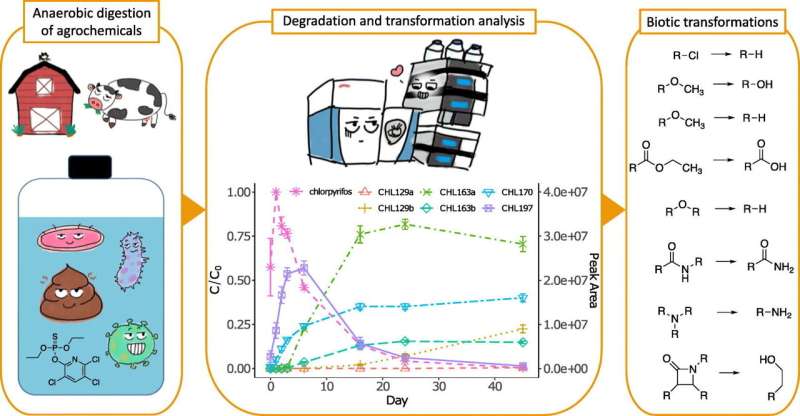This article has been reviewed according to Science X's editorial process and policies. Editors have highlighted the following attributes while ensuring the content's credibility:
fact-checked
peer-reviewed publication
trusted source
proofread
Environmental engineers suggest that anaerobic digestion could be used to clean cattle manure, produce fuel

Chemicals—from antibiotics used to keep livestock healthy to pesticides that shield crops from insects and other pests—play an important role in modern agriculture. However, many of these substances accumulate in cow manure used as fertilizer, where they contaminate crops, leach into groundwater, and pollute waterways, posing a threat to human health and the environment.
A study led by Johns Hopkins environmental engineers suggests that anaerobic digestion—the use of microbes to break down organic matter in the absence of oxygen—could remove these potentially harmful chemicals from cattle manure before they pollute nearby soil and water. What's more, this process can also produce sustainable energy because the organic matter in the manure breaks down to form methane, a biogas.
"The increasing use of antibiotics and pesticides in agriculture present significant risks to human health and the environment, making it crucial to come up with measures to mitigate their negative impact," said team member Carsten Prasse, an assistant professor of environmental health and engineering at Johns Hopkins University. "Our work spotlights the potential of anaerobic digestion as one solution."
The team's results appeared in Science of the Total Environment.
Anaerobic digestion is commonly used to treat sewage sludge in the US. It is also gaining popularity in other countries as a method of processing livestock manure. The main goal of these approaches is to reduce greenhouse gas emissions from the offal, typically stored in large open lagoons. Previous research has primarily focused on the impact of veterinary antibiotics on microorganisms involved in anaerobic digestion.
Prasse's team had a different aim: determining whether anaerobic digestion could be used to remove these chemicals as well as potentially produce biogas. Furthermore, instead of focusing solely on whether anaerobic digestion removed the chemicals, the researchers investigated the substances created during the anaerobic removal process.
"By investigating the pathways by which the microbes broke down the chemicals, we gained insight into what new substances were produced," Prasse said. "This sheds light on which microbes facilitated digestion and whether they succeeded in fully breaking down the 'parent' contaminants or merely transformed them into other, new, and potentially concerning compounds."
In their study, the researchers investigated the fate of 20 common cattle-waste substances in small laboratory containers filled with manure as they underwent anaerobic digestion. They found that 11 of those substances broke down, creating 47 new ones (called "transformation products") in the process.
The team also made another important discovery: Removing chlorine from organic compounds results in less persistent and often less toxic transformation products.
"While our study is a significant step, it also highlights the need for more research to understand the transformation products produced and whether the results can be translated to full-scale treatment systems," Prasse said.
More information: Christopher L. Brueck et al, Assessing the fate of antibiotics and agrochemicals during anaerobic digestion of animal manure, Science of The Total Environment (2022). DOI: 10.1016/j.scitotenv.2022.159156
Journal information: Science of the Total Environment
Provided by Johns Hopkins University





















